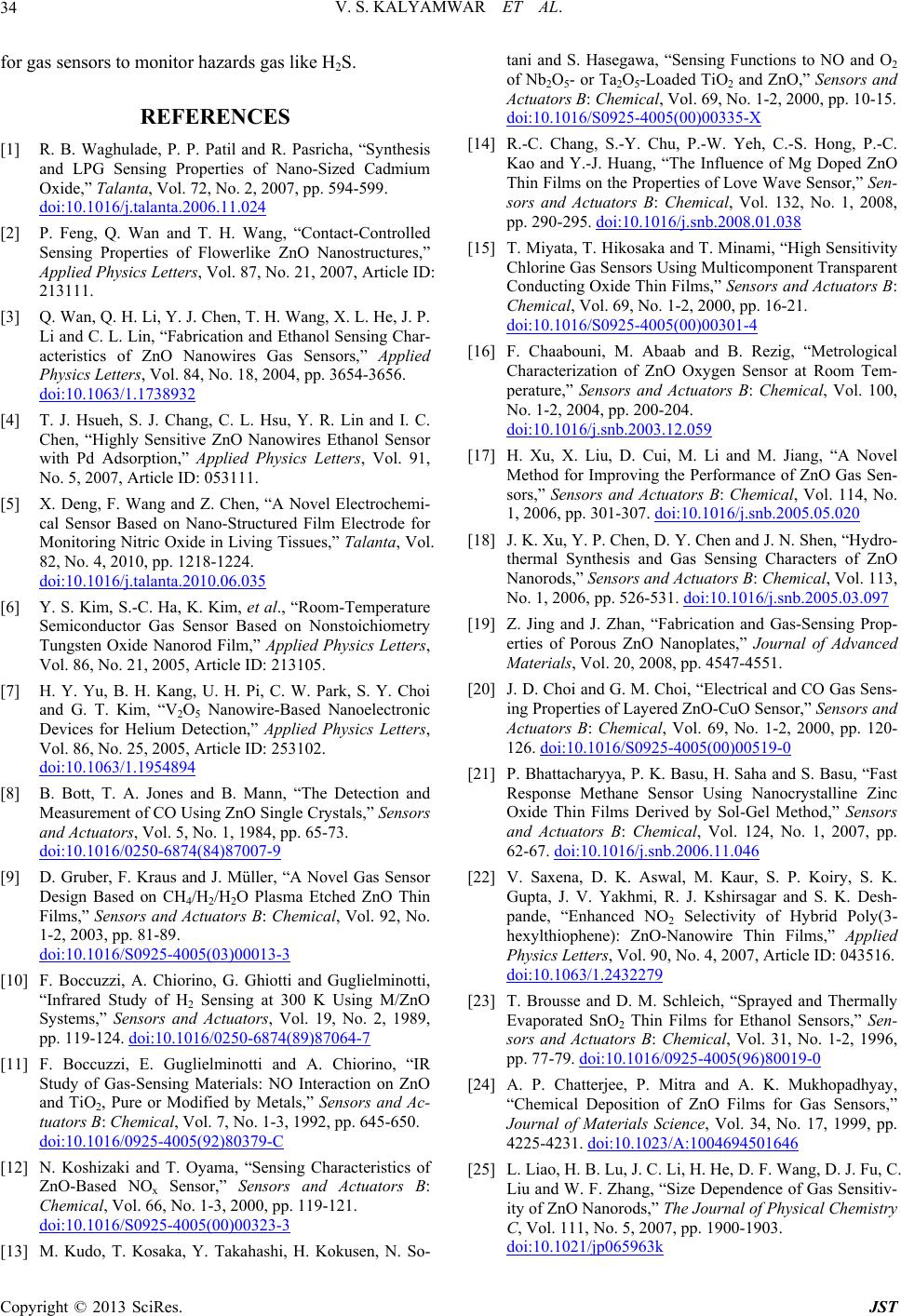
V. S. KALYAMWAR ET AL.
34
for gas sensors to monitor hazards gas like H2S.
REFERENCES
[1] R. B. Waghulade, P. P. Patil and R. Pasricha, “Synthesis
and LPG Sensing Properties of Nano-Sized Cadmium
Oxide,” Talanta, Vol. 72, No. 2, 2007, pp. 594-599.
doi:10.1016/j.talanta.2006.11.024
[2] P. Feng, Q. Wan and T. H. Wang, “Contact-Controlled
Sensing Properties of Flowerlike ZnO Nanostructures,”
Applied Physics Letters, Vol. 87, No. 21, 2007, Article ID:
213111.
[3] Q. Wan, Q. H. Li, Y. J. Chen, T. H. Wang, X. L. He, J. P.
Li and C. L. Lin, “Fabrication and Ethanol Sensing Char-
acteristics of ZnO Nanowires Gas Sensors,” Applied
Physics Letters, Vol. 84, No. 18, 2004, pp. 3654-3656.
doi:10.1063/1.1738932
[4] T. J. Hsueh, S. J. Chang, C. L. Hsu, Y. R. Lin and I. C.
Chen, “Highly Sensitive ZnO Nanowires Ethanol Sensor
with Pd Adsorption,” Applied Physics Letters, Vol. 91,
No. 5, 2007, Article ID: 053111.
[5] X. Deng, F. Wang and Z. Chen, “A Novel Electrochemi-
cal Sensor Based on Nano-Structured Film Electrode for
Monitoring Nitric Oxide in Living Tissues,” Talanta, Vol.
82, No. 4, 2010, pp. 1218-1224.
doi:10.1016/j.talanta.2010.06.035
[6] Y. S. Kim, S.-C. Ha, K. Kim, et al., “Room-Temperature
Semiconductor Gas Sensor Based on Nonstoichiometry
Tungsten Oxide Nanorod Film,” Applied Physics Letters,
Vol. 86, No. 21, 2005, Article ID: 213105.
[7] H. Y. Yu, B. H. Kang, U. H. Pi, C. W. Park, S. Y. Choi
and G. T. Kim, “V2O5 Nanowire-Based Nanoelectronic
Devices for Helium Detection,” Applied Physics Letters,
Vol. 86, No. 25, 2005, Article ID: 253102.
doi:10.1063/1.1954894
[8] B. Bott, T. A. Jones and B. Mann, “The Detection and
Measurement of CO Using ZnO Single Crystals,” Sensors
and Actuators, Vol. 5, No. 1, 1984, pp. 65-73.
doi:10.1016/0250-6874(84)87007-9
[9] D. Gruber, F. Kraus and J. Müller, “A Novel Gas Sensor
Design Based on CH4/H2/H2O Plasma Etched ZnO Thin
Films,” Sensors and Actuators B: Chemical, Vol. 92, No.
1-2, 2003, pp. 81-89.
doi:10.1016/S0925-4005(03)00013-3
[10] F. Boccuzzi, A. Chiorino, G. Ghiotti and Guglielminotti,
“Infrared Study of H2 Sensing at 300 K Using M/ZnO
Systems,” Sensors and Actuators, Vol. 19, No. 2, 1989,
pp. 119-124. doi:10.1016/0250-6874(89)87064-7
[11] F. Boccuzzi, E. Guglielminotti and A. Chiorino, “IR
Study of Gas-Sensing Materials: NO Interaction on ZnO
and TiO2, Pure or Modified by Metals,” Sensors and Ac-
tuators B: Chemical, Vol. 7, No. 1-3, 1992, pp. 645-650.
doi:10.1016/0925-4005(92)80379-C
[12] N. Koshizaki and T. Oyama, “Sensing Characteristics of
ZnO-Based NOx Sensor,” Sensors and Actuators B:
Chemical, Vol. 66, No. 1-3, 2000, pp. 119-121.
doi:10.1016/S0925-4005(00)00323-3
[13] M. Kudo, T. Kosaka, Y. Takahashi, H. Kokusen, N. So-
tani and S. Hasegawa, “Sensing Functions to NO and O2
of Nb2O5- or Ta2O5-Loaded TiO2 and ZnO,” Sensors and
Actuators B: Chemical, Vol. 69, No. 1-2, 2000, pp. 10-15.
doi:10.1016/S0925-4005(00)00335-X
[14] R.-C. Chang, S.-Y. Chu, P.-W. Yeh, C.-S. Hong, P.-C.
Kao and Y.-J. Huang, “The Influence of Mg Doped ZnO
Thin Films on the Properties of Love Wave Sensor,” Sen-
sors and Actuators B: Chemical, Vol. 132, No. 1, 2008,
pp. 290-295. doi:10.1016/j.snb.2008.01.038
[15] T. Miyata, T. Hikosaka and T. Minami, “High Sensitivity
Chlorine Gas Sensors Using Multicomponent Transparent
Conducting Oxide Thin Films,” Sensors and Actuators B:
Chemical, Vol. 69, No. 1-2, 2000, pp. 16-21.
doi:10.1016/S0925-4005(00)00301-4
[16] F. Chaabouni, M. Abaab and B. Rezig, “Metrological
Characterization of ZnO Oxygen Sensor at Room Tem-
perature,” Sensors and Actuators B: Chemical, Vol. 100,
No. 1-2, 2004, pp. 200-204.
doi:10.1016/j.snb.2003.12.059
[17] H. Xu, X. Liu, D. Cui, M. Li and M. Jiang, “A Novel
Method for Improving the Performance of ZnO Gas Sen-
sors,” Sensors and Actuators B: Chemical, Vol. 114, No.
1, 2006, pp. 301-307. doi:10.1016/j.snb.2005.05.020
[18] J. K. Xu, Y. P. Chen, D. Y. Chen and J. N. Shen, “Hydro-
thermal Synthesis and Gas Sensing Characters of ZnO
Nanorods,” Sensors and Actuators B: Chemical, Vol. 113,
No. 1, 2006, pp. 526-531. doi:10.1016/j.snb.2005.03.097
[19] Z. Jing and J. Zhan, “Fabrication and Gas-Sensing Prop-
erties of Porous ZnO Nanoplates,” Journal of Advanced
Materials, Vol. 20, 2008, pp. 4547-4551.
[20] J. D. Choi and G. M. Choi, “Electrical and CO Gas Sens-
ing Properties of Layered ZnO-CuO Sensor,” Sensors and
Actuators B: Chemical, Vol. 69, No. 1-2, 2000, pp. 120-
126. doi:10.1016/S0925-4005(00)00519-0
[21] P. Bhattacharyya, P. K. Basu, H. Saha and S. Basu, “Fast
Response Methane Sensor Using Nanocrystalline Zinc
Oxide Thin Films Derived by Sol-Gel Method,” Sensors
and Actuators B: Chemical, Vol. 124, No. 1, 2007, pp.
62-67. doi:10.1016/j.snb.2006.11.046
[22] V. Saxena, D. K. Aswal, M. Kaur, S. P. Koiry, S. K.
Gupta, J. V. Yakhmi, R. J. Kshirsagar and S. K. Desh-
pande, “Enhanced NO2 Selectivity of Hybrid Poly(3-
hexylthiophene): ZnO-Nanowire Thin Films,” Applied
Physics Letters, Vol. 90, No. 4, 2007, Article ID: 043516.
doi:10.1063/1.2432279
[23] T. Brousse and D. M. Schleich, “Sprayed and Thermally
Evaporated SnO2 Thin Films for Ethanol Sensors,” Sen-
sors and Actuators B: Chemical, Vol. 31, No. 1-2, 1996,
pp. 77-79. doi:10.1016/0925-4005(96)80019-0
[24] A. P. Chatterjee, P. Mitra and A. K. Mukhopadhyay,
“Chemical Deposition of ZnO Films for Gas Sensors,”
Journal of Materials Science, Vol. 34, No. 17, 1999, pp.
4225-4231. doi:10.1023/A:1004694501646
[25] L. Liao, H. B. Lu, J. C. Li, H. He, D. F. Wang, D. J. Fu, C.
Liu and W. F. Zhang, “Size Dependence of Gas Sensitiv-
ity of ZnO Nanorods,” The Journal of Physical Chemistry
C, Vol. 111, No. 5, 2007, pp. 1900-1903.
doi:10.1021/jp065963k
Copyright © 2013 SciRes. JST